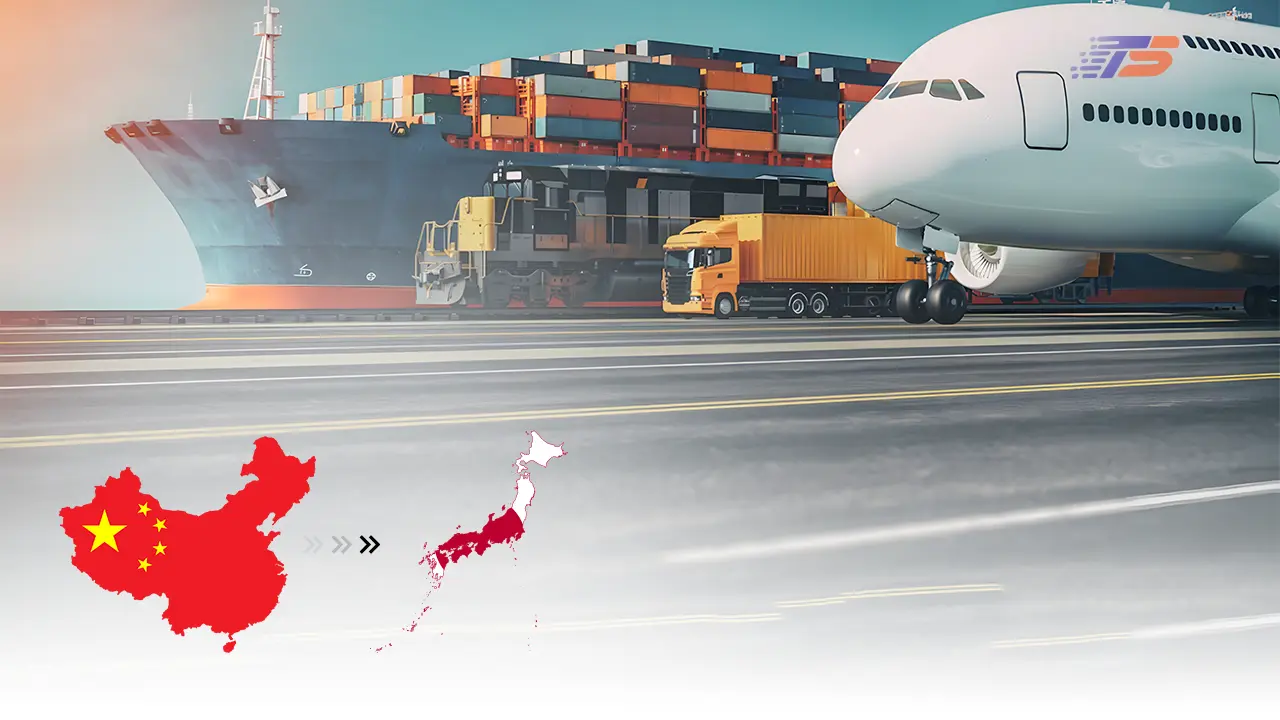Navigating the complexities of shipping from China to Japan has become more critical than ever as trade between these economic powerhouses continues to flourish. With Japan’s imports from China reaching $167.12 billion and exports to China totaling $124.63 billion in 2024, businesses need reliable logistics solutions to capitalize on this trade relationship.
Shipping from China to Japan Overview 2025
In 2025, shipping from China to Japan continues to support robust trade between the two countries. Businesses benefit from reliable transit times, clear customs procedures, and flexible options that match different cargo volumes and urgency levels. Here’s a quick look at shipping costs and times.
Costs
- Air freight (1,000kg+ to Tokyo): ~$1.50/kg
- Sea freight (20′ to Tokyo/Yokohama): $300
- Sea freight (40′ to Tokyo/Yokohama): $500
- Express shipping (under 100kg): ~$6.50/kg
Delivery Times
| Mode | Route | Transit Time |
| Express | China → Japan | 2-3 days |
| Air freight | China → Tokyo/Osaka | 1-3 days |
| Sea freight (FCL) | Shanghai → Tokyo | 5-7 days |
| Sea freight (LCL) | China → Yokohama | 7-10 days |
China to Japan Delivery Methods: Ocean vs Air vs Express
Evaluating the proper shipping method from China to Japan starts with understanding your business priorities and the specifics of your cargo. Budget limits, delivery timelines, cargo value, and shipment volume all influence the best approach. Each shipping method whether sea, air, or express offers distinct benefits depending on the type of goods and urgency of delivery.
| Method | Transit Time | Best For |
| Express | 2-3 days | High-value, urgent shipments under 100kg |
| Air Freight | 1-3 days | Time-sensitive cargo, electronics, pharmaceuticals |
| Sea Freight (FCL) | 5-7 days | Large volume, cost-sensitive bulk shipments |
| Sea Freight (LCL) | 7-10 days | Small to medium shipments, mixed cargo consolidation |
International Door-to-Door Delivery
Door-to-door delivery simplifies the entire shipping from China to Japan process by consolidating pickup, transit, customs clearance, and final delivery into a single service. This comprehensive solution includes shipping fees, taxes, export customs clearance and import customs clearance, eliminating the need for multiple service providers. The process begins with cargo collection from your Chinese supplier’s facility, followed by export documentation and customs clearance in China.
Upon arrival in Japan, professional customs brokers handle import clearance, duty payments, and regulatory compliance before arranging final delivery to your designated address. Essential documentation includes invoices, packing lists, and certificates of origin to comply with both Chinese and Japanese customs regulations, with import duties and taxes calculated automatically using our duty calculator and paid as part of the service.
Amazon FBA Shipping
Amazon FBA sellers targeting the Japanese market require specialized logistics support to meet Amazon’s stringent fulfillment requirements. Amazon FBA box weight restrictions limit individual packages to 50 lbs. (23 kg) unless single items exceed this weight, while products need either manufacturer EAN/UPC/GTIN codes or Amazon FNSKU labels applied before shipment.
Professional freight forwarders provide comprehensive FBA prep services including product inspection, compliant labeling, poly bagging for fragile items, and direct shipment to Amazon fulfillment centers in Japan. Complete prep services include contacting Amazon staff, generating FBA labels, proper packaging, invoice preparation, and photo documentation for any non-compliant products. This integrated approach ensures your inventory meets Amazon Japan’s standards while maintaining optimal delivery speeds to Japanese customers through Amazon’s local fulfillment network.
Container Types for Ocean Freight
Familiarity with container sizes can also help control costs and protect your cargo. A standard 20ft container provides roughly 33 cubic meters of space, while a 40ft container offers around 67 cubic meters, allowing for efficient planning of shipments and maximizing container utilization.
Familiarity with container sizes can also help control costs and protect your cargo. A standard 20ft container provides roughly 33 cubic meters of space, while a 40ft container offers around 67 cubic meters. Use our cubic calculator to plan your shipments efficiently and maximize container utilization.
| Container Type | Internal Dimensions (L × W × H) | Max Volume (CBM) | Best Use Case |
| 20ft Standard | 5.89m × 2.35m × 2.39m | 33 CBM | Small to medium shipments, testing market |
| 40ft Standard | 12.03m × 2.34m × 2.34m | 67 CBM | Large volume shipments, regular imports |
| 40ft High Cube | 12.03m × 2.34m × 2.69m | 76 CBM | Lightweight, voluminous cargo |
Actual Transit Times for China to Japan Shipments
For B2B importers, transit time directly impacts inventory planning, cash flow, and customer satisfaction. Faster shipping allows businesses to respond quickly to market demand and reduce stock shortages, while longer transit times can lower shipping costs but require careful forecasting. Understanding estimated delivery durations helps importers choose the right balance between speed and cost for each shipment.
| Shipping Method | Transit Time (Port/Airport to Port/Airport) | Customs Clearance & Handling | Total Estimated Delivery Time (Door-to-Door) | Best Suited For |
| Express Shipping | N/A (Direct delivery) | 1 day | 2-3 days | Urgent, high-value shipments |
| Air Freight | 1-3 days | 1-2 days | 3-5 days | Time-sensitive electronics, pharmaceuticals |
| Sea Freight (FCL) | 3-7 days | 2-3 days | 5-10 days | Large volume, cost-effective shipments |
| Sea Freight (LCL) | 6-15 days | 3-4 days | 9-19 days | Small to medium consolidated cargo |
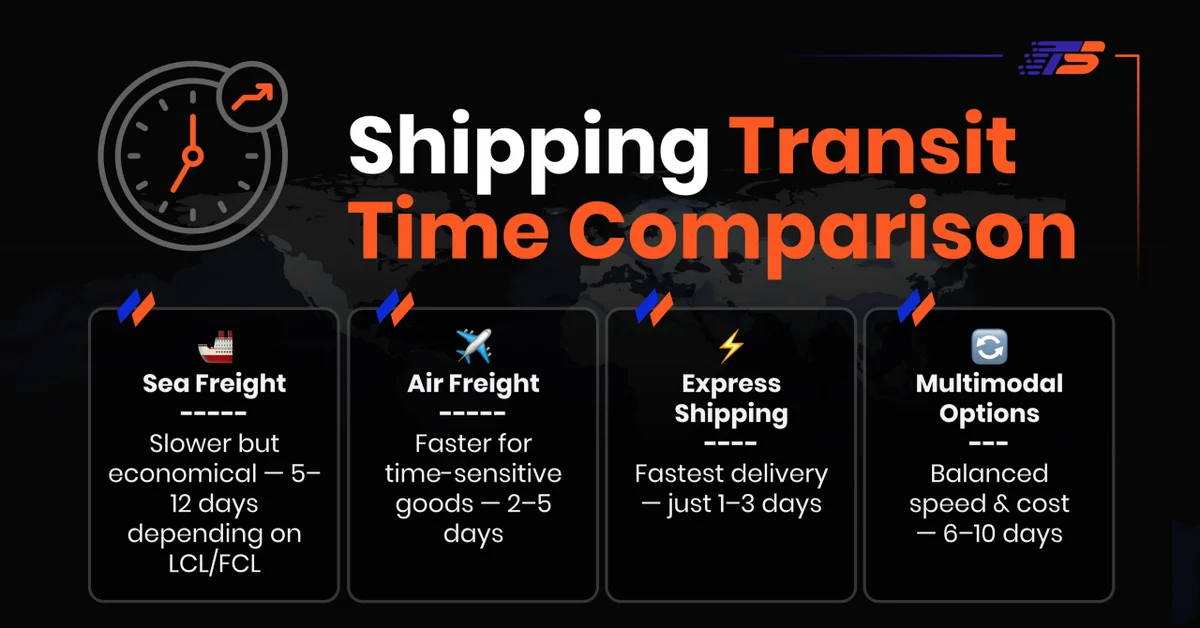
What Factors Affect Transit Time China-Japan?
- Weather Conditions: Severe weather including storms, typhoons, and heavy snow can delay both sea and air transport, particularly affecting vessel routes and flight schedules
- Port Congestion: High traffic volumes at major ports create loading delays and extended waiting times for both departure and arrival terminals
- Peak Season Impact: High demand periods overwhelm shipping services, causing significant delays beyond normal transit times, especially during Chinese New Year and holiday seasons
- Customs Inspection Delays: Random inspections, incomplete documentation, and regulatory compliance checks extend clearance processing times
- Route Distance: Shorter routes like Shanghai to Tokyo offer faster transit (3-6 days) compared to longer routes requiring additional stops
- Carrier Availability: Limited vessel or aircraft capacity during busy periods affects booking availability and departure schedules
China to Japan Shipping Rates: Cost Factors & Breakdown
Clear and transparent shipping costs are essential for B2B importers to plan budgets accurately and avoid unexpected expenses. Knowing the full price upfront including freight, customs, and handling helps businesses compare shipping methods, make informed decisions, and maintain healthy profit margins. Transparent pricing also builds trust with freight partners, ensuring smoother and more predictable logistics.
| Service Type | Cost Range | Minimum Charge | Best For | Estimated Transit Time (Door-to-Door) |
| Express Shipping | $6-8/kg | $50 | Urgent, high-value items under 100kg | 2-3 days |
| Air Freight | $1.50-3/kg | $200 | Electronics, pharmaceuticals, time-sensitive cargo | 3-5 days |
| Sea Freight (LCL) | $80-150/CBM | $100 | Small to medium consolidated shipments | 9-19 days |
| Sea Freight (FCL 20ft) | $300-500 | $300 | Full container loads, cost-effective bulk | 5-10 days |
| Sea Freight (FCL 40ft) | $500-800 | $500 | Large volume shipments, maximum savings | 5-10 days |
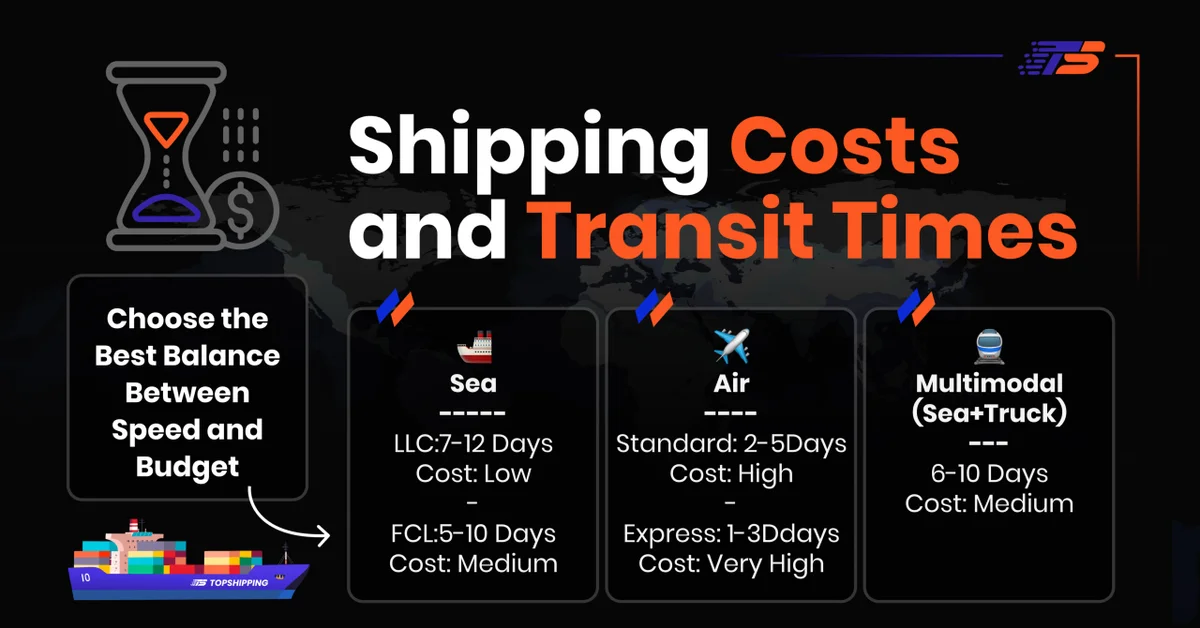
Shipping Cost Example: Bulk Textiles (Sea Freight – FCL)
- Key cost factors: Port congestion fees, container detention charges, destination handling
- Route: Shanghai → Osaka
- Cargo: 15 tons fabric rolls (20ft container)
- Method: Full Container Load (FCL)
- Base shipping cost: $1,200-$1,500
- Fuel surcharges (BAF/CAF): $150-$250
- Customs clearance & inspection fees: $80-$150
- Warehouse storage fees (if applicable): $50-$100 per day
- Total estimated cost: $1,480-$2,000
- Transit time: 3-5 days
Factors Affecting Shipping Costs
- Fuel Price Fluctuations: Changes in oil prices trigger rate adjustments through Global Fuel Surcharge (GFS) and Bunker Adjustment Factor (BAF)
- Distance and Route: Longer journey distances and less popular shipping routes result in higher freight charges
- Container Type and Size: Standard 20ft and 40ft containers have different rates, while specialized containers command premium pricing
- Seasonal Demand: Peak Season Surcharge (PSS) applies during high-demand periods like Chinese New Year and holiday seasons
- External Disruptions: Weather disruptions, labor strikes, and port congestion directly impact shipping costs and delivery schedules
- Cargo Weight and Volume: Heavier and bulkier shipments incur higher charges based on chargeable weight calculations
- Additional Surcharges: Terminal handling charges (THC), currency adjustment factors (CAF), and customs processing fees add to base transport costs
Main China to Japan Shipping Routes: Key Ports & Destinations
Major Departure Ports in China
- Shanghai Port: World’s busiest container port handling over 50 million TEUs annually, primary gateway for China-Japan trade
- Ningbo-Zhoushan Port: Connected to 90 countries and 560 ports worldwide, specialized terminals for containers and bulk cargo
- Shenzhen Port: Major southern China gateway with modern container facilities and efficient processing capabilities
- Qingdao Port: Northern China’s key maritime hub offering comprehensive logistics services and container handling
- Tianjin Port: Strategic location serving Beijing area with advanced container terminals and multimodal transport connections
- Xiamen Port: Important southeastern China port with direct Japan routes and specialized cargo handling facilities
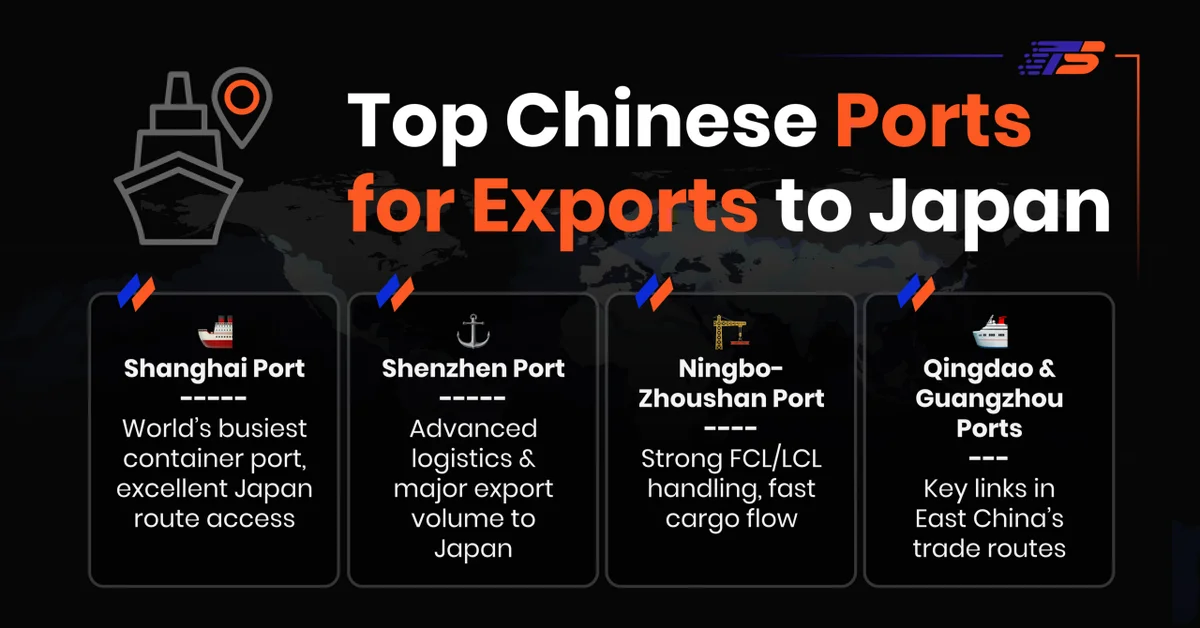
Primary Arrival Ports in Japan
- Tokyo Port: Major metropolitan gateway handling diverse cargo types with modern container terminals
- Yokohama Port: Handles around 30% of Japan’s ocean freight, strategic location near Tokyo Bay
- Osaka Port: Key Kansai region hub serving western Japan with extensive container and bulk cargo facilities
- Kobe Port: Historic international gateway specializing in steel, machinery, and textile imports
- Nagoya Port: Japan’s largest port by cargo volume, central location serving industrial heartland
- Hakata Port: Important gateway to Kyushu region with efficient container handling capabilities
Air Freight Hubs (China and Japan)
- China: Shanghai Pudong (PVG), Beijing Capital (PEK), Guangzhou Baiyun (CAN), Shenzhen Bao’an (SZX)
- Japan: Narita International (NRT), Kansai International (KIX), Chubu Centrair (NGO), Haneda (HND)
Efficient Route Combinations
- Shanghai to Tokyo/Yokohama: Most popular route with 3-6 day transit time and high frequency services
- Ningbo to Yokohama: Alternative eastern route offering 5-9 day transit with competitive pricing
- Qingdao to Osaka: Northern China to western Japan route serving Kansai region in 7-12 days
- Shenzhen to Kobe: Southern China route ideal for electronics and consumer goods with reliable schedules
China to Japan Shipping: Customs, Duties & Insurance Guide
When shipping from China to Japan, properly handling custom clearance, duties, and insurance is crucial for smooth delivery. Accurate documentation and compliance with Japanese import regulations prevent delays, fines, and shipment rejections. Insurance protects high-value or fragile cargo against loss or damage during transit, giving importers peace of mind and financial security.
Japan Customs & Import Duties
Japan imposes a 10% consumption tax (standard rate) or 8% (reduced rate) on all imported goods, calculated based on customs value plus customs duty. Japan maintains one of the world’s lowest average applied tariff rates, with simple average Most Favored Nation (MFN) tariff for manufactures at 1.1% .Import duties vary by product category using HS codes, with electronics typically ranging 0-5%, textiles 5-12%, and automobiles around 0%. Additional fees include handling charges and documentation processing costs.
Cargo Insurance Protection
Cargo insurance protects against loss, damage, or theft during China to Japan shipping. Standard coverage ranges 0.3-0.5% of cargo value for sea freight and 0.1-0.3% for air freight. Insurance covers perils of the sea, fire, theft, general average, and total loss scenarios. Essential for high-value electronics, machinery, and fragile goods requiring comprehensive protection throughout the transit process.
HS Codes for China-Japan Shipping
HS (Harmonized System) codes are standardized 6-10 digit product classification numbers used globally to identify goods during customs clearance. Each product type has a unique HS code that determines applicable import duties, taxes, and regulatory requirements. When shipping from China to Japan, accurate HS code classification is essential. Incorrect codes can lead to customs delays, additional inspection fees, or penalties. Your freight forwarder or customs broker can help identify the correct HS code for your products, ensuring smooth clearance and accurate duty calculations.
- Electronics: 8471 (computers), 8517 (telecommunications), 8528 (monitors/displays)
- Machinery: 8479 (industrial machines), 8483 (transmission components)
- Textiles: 6109 (t-shirts), 6204 (women’s clothing), 6403 (footwear)
- Automotive: 8708 (auto parts), 8711 (motorcycles)
- Consumer goods: 9503 (toys), 4202 (bags/cases)
Incoterms & Delivery Options China Shipping To Japan
- FOB (Free on Board): Seller responsible until goods loaded on vessel, buyer handles sea freight to Japan and import procedures
- CIF (Cost, Insurance, Freight): Seller covers shipping and insurance to Japan port, buyer handles customs clearance
- DDU (Delivered Duty Unpaid): Seller delivers to Japan destination, buyer pays import duties and taxes
- DDP (Delivered Duty Paid): Seller handles complete delivery including all duties and taxes
DDP vs DDU: Best Shipping Terms for China to Japan
DDP means the supplier pays all import/export costs, with buyer only responsible for receiving goods. DDU requires seller to deliver goods safely to destination port, with buyer handling customs duties and final delivery. DDP offers simplicity for importers but higher costs, while DDU provides cost transparency and buyer control over customs processes. Choose DDP for streamlined operations or DDU for better cost management and customs oversight.
International Freight Forwarder from China to Japan
Professional freight forwarders simplify complex international shipping from China to Japan by managing documentation, customs clearance, and multimodal transport coordination. Licensed forwarders must obtain import/export licenses, international freight forwarding filing, NVOCC registration, and ground-transportation operating licenses.
These specialists handle commercial invoices, packing lists, bills of lading, and customs documentation while ensuring regulatory compliance for both countries. Experienced forwarders provide warehousing services, cargo consolidation, insurance arrangements, and end-to-end shipment tracking for seamless China to Japan shipping.
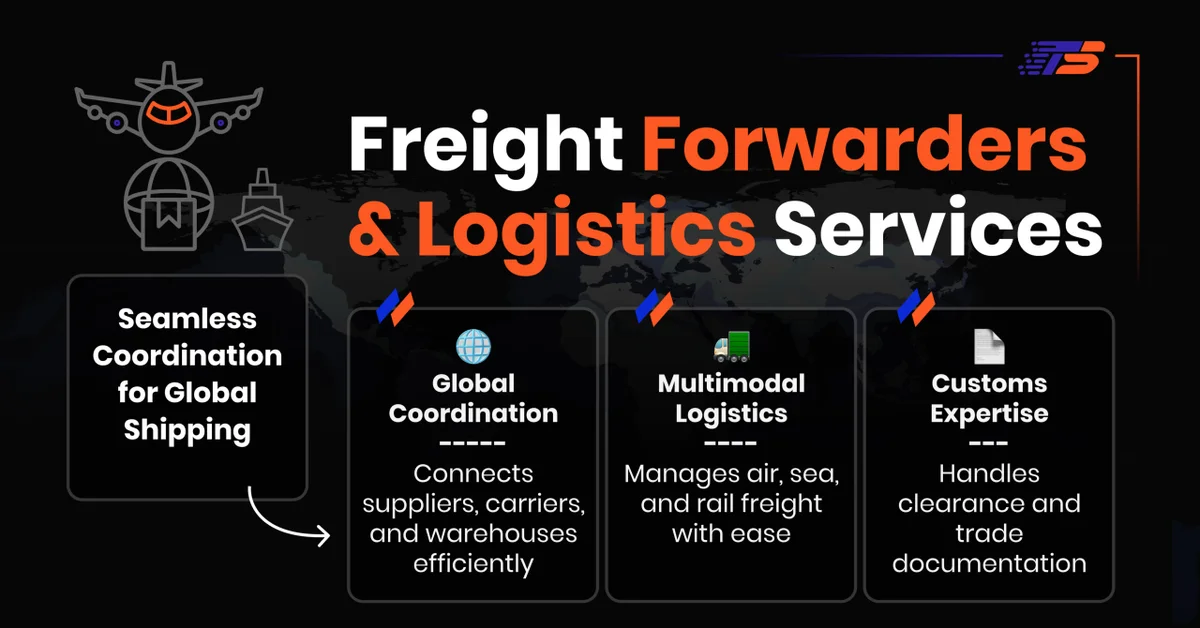
What to Look for in a China to Japan Freight Forwarder
- Verify Licensing Requirements: Ensure your provider has the appropriate licenses for handling cargo as well as special licenses if your goods require them, including proper Chinese export and Japanese import authorizations
- Experience with Japan Routes: Opt for reliable freight forwarders who have proven efficient in handling and navigating delays specific to China-Japan trade corridors and Japanese customs procedures
- Technology Integration: Modern tracking systems, online booking platforms, and real-time shipment visibility enhance operational transparency and cargo monitoring capabilities
- Local Market Knowledge: Deep understanding of Japanese import regulations, required shipping documents including commercial invoice, packing list, and bill of lading or air waybill, plus any product-specific certifications
- Service Range Evaluation: Comprehensive services including warehousing, consolidation, customs brokerage, door-to-door delivery, and specialized handling for electronics or fragile goods
- Communication Standards: Clear communication is essential – freight forwarders should be proficient in English and understand your requirements without confusion
- Financial Stability: Review company credentials, insurance coverage, and financial standing to ensure reliable partnership for ongoing trade relationships
Track Your China to Japan Shipment: Available Tools
B2B importers benefit from real-time tracking that provides full visibility over their shipments from China to Japan. Modern logistics platforms provide real-time visibility throughout your shipping journey from China to Japan:
- Freight Forwarder Tracking Portals: Monitor your cargo’s location, customs status, and estimated delivery time using your booking or container number through online dashboards
- Ocean Carrier Mobile Apps: Receive live updates and notifications at key milestones such as departure, transit, and arrival at destination ports
- Air Freight & Express Courier Tracking: Access detailed scan events at every checkpoint from pickup to final delivery with precise timestamp information
- Third-Party Tracking Aggregators: Monitor shipments from multiple carriers in one centralized dashboard for streamlined logistics management
- GPS-Enabled Containers & IoT Sensors: Track high-value shipments with real-time location data, temperature monitoring, and cargo integrity alerts to prevent losses and damage
Service-Based Tracking
Different shipping methods sea freight, air freight, and express services offer tailored tracking features. Air and express shipments typically provide more frequent updates, while sea freight tracking focuses on port departures, arrivals, and container status. Choosing the right service ensures the level of visibility your business requires.
China to Japan Shipping: Prohibited & Restricted Items
Shipping from China to Japan requires attention to cargo type, regulations, and handling requirements to ensure smooth delivery and compliance.
Sensitive & Special Cargo Handling:
- Narcotics & Controlled Substances: Heroin, cocaine, MDMA, opium, cannabis, stimulants, psychotropic substances, and other narcotic drugs (excluding those designated by Japanese authorities)
- Firearms & Ammunition: Including pistols, rifles, machine guns, and firearm parts
- Explosives & Hazardous Materials: Such as dynamite, gunpowder, and precursor materials for chemical weapons
- Counterfeit Goods: Including altered or imitation coins, paper money, bank notes, securities, and forged credit cards
- Obscene Materials: Including child pornography and materials that may harm public safety or morals
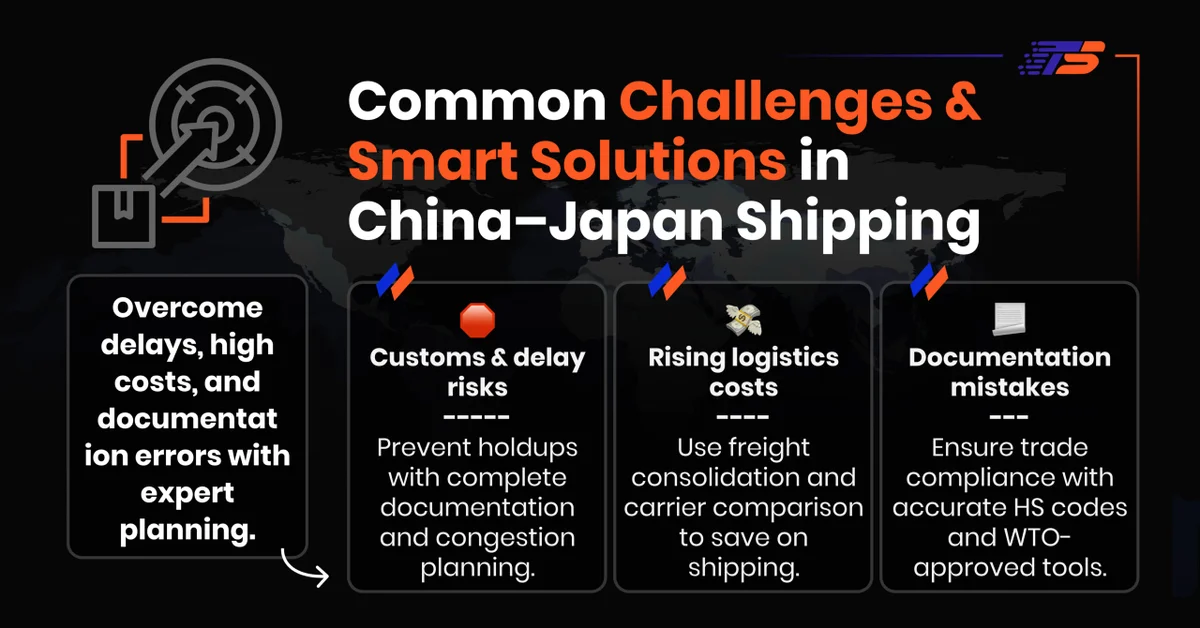
Prohibited and Restricted Items:
- Lithium Batteries: Subject to specific regulations and may require special handling
- Plants & Agricultural Products: May require phytosanitary certificates and are subject to inspection
- Animal Products: Including meat, dairy, and other animal-derived goods, often requiring veterinary certificates
- Medical Devices & Pharmaceuticals: Must comply with Japan’s Pharmaceutical and Medical Device Act and may require import licenses
- Precious Metals & Gemstones: Including gold, diamonds, and other precious materials, subject to specific import regulations
Final Thoughts: Shipping from China to Japan
Efficient shipping from China to Japan depends on choosing the right method for your cargo and business needs. Sea freight works best for large shipments, air freight for urgent orders, and express services for smaller, high-priority goods. Keep an eye on customs, duties, and prohibited items, and make sure your shipments are properly insured. With transparent pricing, real-time tracking, and reliable freight partners, you can minimize delays, reduce risks, and keep your supply chain predictable and stress-free.
FAQ – Shipping from China to Japan
How long does it take to ship from China to Japan?
Shipping time depends on the method chosen. Sea freight usually takes 5–10 days for full container loads (FCL) and 7–12 days for less-than-container loads (LCL). Air freight can deliver in 2–5 days, while express courier services like DHL or FedEx typically take 1–3 days.
How much is shipping from China to Japan?
Costs vary by shipment size, weight, and service type. LCL shipments are usually priced per cubic meter, while FCL shipments depend on container size. Air freight is generally higher per kilogram, and express services are the most expensive but fastest.
Why is Japan Post taking so long?
Delays may result from high parcel volume, customs clearance, or local transportation bottlenecks. Using a reliable freight forwarder with tracking can minimize uncertainty.
How much does it cost to ship from China to Japan?
Shipping costs depend on weight, volume, and service type. Sea freight is most economical for bulk cargo, air freight is costlier but faster, and express services offer speed for small packages.
How much will it cost to ship a package to Japan?
Small packages via express couriers are typically $20–$50 for 1kg, depending on carrier and service. Larger shipments should be quoted through a freight forwarder for accuracy.
What is the cheapest way to get from China to Japan?
Sea freight is the most cost-effective method for larger shipments. Consolidating multiple smaller shipments into LCL can also reduce costs.
What is the fastest way to ship something to Japan?
Express couriers (DHL, FedEx, UPS) are the fastest, followed by air freight. Sea freight is slower and better suited for non-urgent bulk cargo.
How fast can FedEx ship to Japan?
FedEx International Priority typically delivers within 1–3 business days from China to Japan, depending on pickup location and customs clearance.
What is the fastest international shipping service in Japan?
For inbound shipments, DHL Express, FedEx International Priority, and UPS Worldwide Express are fastest, delivering in 1–3 days.
Can you ship to Japan via USPS?
Yes, USPS offers international services to Japan, but delivery times are slower (7–21 days) and tracking may be limited. B2B importers often prefer courier or freight services.

